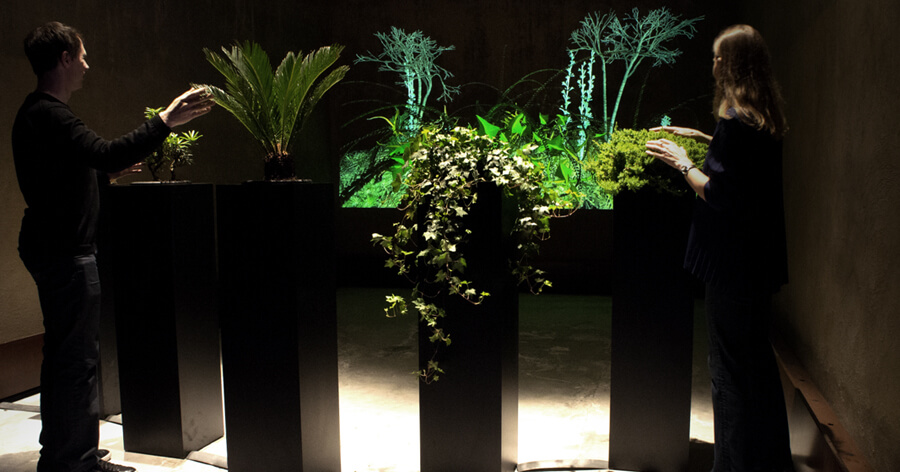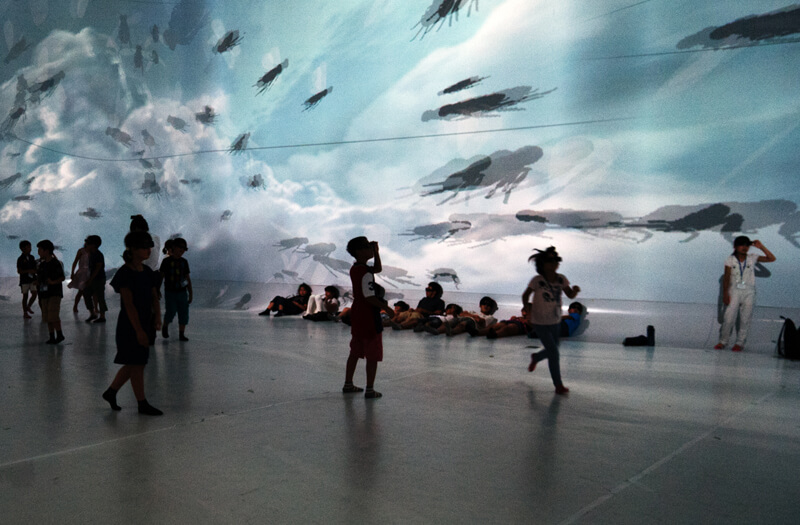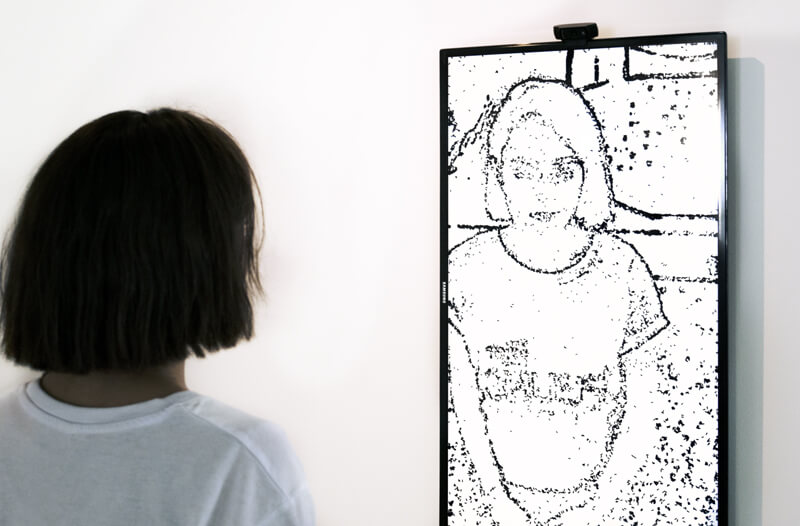Interview by Bilge Hasdemir

Christa Sommerer & Laurent Mignonneau are internationally renowned media artists and pioneering names in the media art scene. Interaction is one of the significant components of Sommerer & Mignonneau’s works. With their identification, they are interested in creating living systems by aiming to question life at different levels.
Thus, interaction encompasses both physical and mental involvements and occurs between humans and machines and real and artificial. The distinguishing characteristics of their works hinge on new types of interfaces and interaction scenarios they develop and their complex cultural connotations.
Sommerer & Mignonneau were also two of the artists of the Artistes & Robots exhibition (2018) at Le Grand Palais in Paris. They participated in this fascinating artificial life and imagination-focused exhibition with the interactive installation Portrait on the Fly (2015). In the piece, the audience stands in front of the monitor, which shows the swarming of thousands of flies.
Once the audience is detected, the silhouette of her/him gradually appears on the screen with a tacit reference to the selfie culture of our era. The portraits, which are composed of artificial flies and in constant flux, are composed & de/recomposed continuously depending on the interference of the audiences.
There are also a series of plotter drawings of Portrait on the Fly, by which artists contribute significantly to media arts’ cultural heritage. By referencing discussions surrounding ephemerality in media arts and archival response, portraits of prominent figures in the field of media arts become part of a personal media art collection.
Apart from these recent examples, many of their early interactive works, in which the audience becomes part of an artificial ecosystem, have become canonical examples in new media art. Interactive Plant Growing (1992), an interactive computer installation combining botany, art and electronics and taking part in the permanent collection of the ZKM, is the first piece artists use a natural interface to connect the real and the artificial. The tactile experience of touching a living plant enables visitors to initiate the real-time growth of artificial plants.
A-Volve (1994) is another forerunner work that artists involved in generative art and A-Life. The installation allows the audience to interact with computer-generated artificial creatures which have life-like behaviours. By applying real-life principles to the artificial living system, Sommerer & Mignonneau enable the audience to control those creatures’ birth, creation, reproduction and evolutionary processes. Opening up their artistic creation process to include the audience as an essential developmental factor, they do not refrain from giving the audience responsibility for the lives of artificial organisms.
Both Interactive Plant Growing and A-Volve show that the distinction between real and artificial and carbon-based and silicon-based life forms has become intertwined. Media archaeological reflections in Escape (2012), Excavate (2012), and Life Writer (2004) are also worth mentioning. The audience can explore artificial life from a media archaeological approach by transforming archaeological media devices into interface devices and combining old and new or early and latest technologies.
The interface variety results from essential research processes in which each concept is developed with implicit reference to the relations among society, media and culture by taking into account the interface culture of its day. It must also be noted that in addition to their ground-breaking works in the field of new media art and interactive art, Sommerer & Mignonneau also offer insightful contributions to discussions around (new) media art market, the attention economy and digital heritage and play a particularly important role in the development of media art culture.


You both have multidisciplinary backgrounds in art and science, and you are one of the pioneers of using a diverse array of new media to address the crossover of art and science. How and when do all these interests come about?
We have been working at various research centers such as the Beckman Institute in Champaign Urbana or the ATR Advanced Telecommunication Laboratories in Kyoto, Japan. For us, the context of human-computer interaction is very interesting as it helps us to come up with new ideas for audience participatory systems that are conveying an artistic message. An example is our “Interactive Plant Growing” installation from 1992, combining botany, art and electronics. These days the field of artistic research has become very diversified, and artists are now much more free to combine various disciplines and methods. These interdisciplinary combinations can be a great resource of inspiration for artists.
In Artistes & Robots, contemporary works are presented alongside visionary icons; we imagine guiding the audience through a journey on how artists have explored these topics and disciplines. What were the most significant challenges you faced during its development?
This exhibition provides an excellent overview of how artists over the past 50 or more years have been interested in challenging the artistic creation process per se. Examples by Jean Tinguely, who designed a machine that produces automatic drawings in the 1960s, to Vera Molnar and Manfred Mohr, who were some of the first artists to use computers in the 1970s, to pioneers such as Stelarc, who creates art using his body and robotics, the exhibition also provides recent examples of artists, including ourselves, who use generative processes and audience participation. We see our contribution in interactive and generative art, where the artistic creation process has been opened up to include the audience as an important developmental factor.
What do you expect from the audience interacting with the pieces?
In our interactive installation Portrait on the Fly by Laurent Mignonneau and Christa Sommerer from 2015, the audience is confronted with a large screen that displays around 10.000 small flies which swarm around. Once a person positions himself in front of the screen, he or she will see her own silhouette gradually appear, composed by the little flies that try to sit on any outline they detect. As a result, the person will slowly recognise that this is him-/herself and start to experiment by attracting and chasing away the flies through body gestures.
Since the process is fluid and ephemeral and images exist only in a very short instant, people stay quite long and start improvising with the installation. For us this is really interesting, as we want to create very open-ended and participatory artworks that fascinate the audience and convey an artistic message to people through embodied interaction.
How do you predict the future of AI-generated art?
Like A-life, generative algorithms and complex system principles, Artificial Intelligence has fascinated artists for a long time. These methods and principles allow us to explore what creation is further. We have been involved in generative art and Artificial Life for a long time. An example is the “A-Volve” installation from 1994.
Creation can be understood as the creation of life but also as the creation of creation. Artists can now use machine learning algorithms and large database repositories and combine them with user participation: this will allow an even larger palette of generative systems, where computer systems can make propositions that artists can use, adapt, challenge and subvert. AI will not replace art creation. It will become an additional feature that inspires artists to create novel systems that could not have been done previously.
What projects/research are keeping you busy besides the Artistes et Robots exhibition?
Right now, we are working on a VR project called Fly Simulator. It is an immersive experience where a few thousand flies organise themselves into swarms, creating interesting patterns when a user wears the 3D headset. The would-walk head position influences the swarming of the flies, and as the virtual space is based on a non-Carthesian world with unusual perspectives and timing, the user feels like she has become a fly herself.
The work is also based on a VR project called Flies in the Sky, which we realised at Tsukuba University in Japan in 2017. The second project we are working on is a continuation of our “Neuro Mirror” project from 2017. It is an interactive installation where visitors see themselves on three screens, arranged like a triptych. The screen in the middle displays the participant’s image in real-time, while the screen on the left shows his or her image from the past.
The screen on the right, however, represents the future, a alter ego, where the participant’s actions are approximated from his or her past actions using machine learning algorithms. The concept of this artwork is to deal with one´s self-image through a digitally enhanced mirror interface. We also work on this project with the BEALL Art Center at the University of Irvine in California.
Your work has frequently encompassed the use of interfaces. New digital interfaces seem to blur the physical and digital boundaries. How people respond to multiple stimuli in a digital environment beyond the touch of a screen or button is one of the questions to answer in this 21st century in which people live in a hyper-connected society. What impact do you predict for them in the not-too-distant future?
Yes, we are now at a very interesting point in time. While in the 90s until recently, people happily embraced any form of new technology, mobile devices and social media platforms and trusted large corporations who provided these systems, we can now witness a very critical and anxious attitude.
The blurring of the analogue and digital world will continue to become even more seamless, and interfaces will become more and more hidden. The new challenge in the future will be to create sustainable and ethical interfaces where users know what happens with their data and their privacy and where they can control and capitalize on their data if they want.
Are there any unexplored territories you’d like to take your practice to?
Yes, there many things to do for artists these days. We have to get involved in all the technical as well as social developments in media art and media technology. We need to shape this field with our inventions, prototypes and artworks. This can be on the educational level and through creating artworks we share with a large public. We would like, for example, to create more large-scale projects for media facades, as we did for the “Fly High Time Flies” project at the ICC Tower in Hong Kong in 2016.
What is your chief enemy of creativity?
Creativity is not a problem at all. Only the time to realise all the ideas is an issue.
You couldn’t live without…
Curiosity and freedom.






